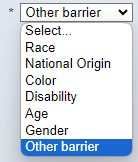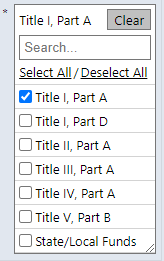You are here
General Education Provisions Act (GEPA)
Requirement
Section 427 of the United States Department of Education's General Education Provisions Act (GEPA) requires each applicant for funds (other than an individual person) to include in its application a description of the steps the applicant proposes to take in order to ensure equitable access to, and participation in, its Federally-assisted programs for students, teachers, and other program beneficiaries.
Local education agencies (LEAs) or other eligible applicants that apply for Federal funding through the ESEA consolidated application must provide this description in their application. CDE is responsible for ensuring that the LEA or other local entity has submitted a sufficient GEPA statement.
| A GEPA statement is… | A GEPA statement is not… |
|---|---|
| An opportunity for LEAs to address unintended barriers to access and participation in Federally-funded programs. | An admission of discrimination. |
| A statement that can be updated each time the LEA applies for federal funds. | The same as the LEA’s vision, mission, equity, or anti-discrimination policy. |
Developing a Response
GEPA allows applicants discretion in developing and describing the activities that occur to meet this requirement. The statute highlights six types of barriers that may impede equitable access or participation: gender, race, national origin, color, disability, or age. Guidance from the U.S. Department of Education in 2023 listed additional considerations, which include but are not limited to: language, migrant status, rural status, homeless status or housing insecurity, pregnancy, parenting, or caregiving status, and sexual orientation. Based on local circumstances, LEAs should identify and address any systemic barriers that may prevent students, teachers, or other beneficiaries from accessing or participating in the Federally-funded activities.
Guiding Questions
When creating the GEPA statement for the ESEA Consolidated Application, an LEA may consider the following questions while reflecting on a particular activity or program funded with ESEA funds:
-
What students, staff, and other beneficiaries might participate in or benefit from this activity?
-
What needs might the participants have?
-
What is a potential barrier that could arise or what systemic conditions may prohibit or limit participation in programs?
-
What are the strategies and action steps necessary to address, prevent, or mitigate this barrier before the barrier prevents participation or restricts access?
-
Who will be responsible for implementing the necessary strategies and steps?
-
What is the timeline of when the strategies will be implemented?
Example
Based on the LEA’s plan for ESEA funds in the Consolidated Application, select the potential systemic barriers which may prevent students, educators, or other program beneficiaries from historically underserved populations listed below from accessing, or participating in, one proposed activity. If “other historically underserved population” is selected, please provide a description of the population.

Other historically underserved populations: Migrant students and students experiencing poverty
Describe the proposed activity and the potential barrier for access to, or participation in, the activity.
The LEA plans to utilize Title I, Part A funds for supplemental tutoring. An after school tutoring program could create several potential barriers to access and participation in the tutoring program. The high mobility of some migrant families may lead to communication gaps and consistent access to programming. Migrant students who may work with their family after school may not be able to attend due to after school work schedules. The timing may also create transportation barriers for students experiencing poverty who do not have access to transportation aside from the school bus.
Describe the strategies the LEA will implement to ensure equitable access to the activity.
To address these barriers, communication about the tutoring program will be on-going and shared with families via the school webpage, e-newsletters, social media, phone blasts, and posters in the school building hallways, as well as letters mailed to the families home. The LEA will offer the tutoring program during school hours three days per week during homeroom time in addition to the after school program four days per week. An all-day tutoring session will be provided once per month to allow for make-up sessions for any tutoring missed during the school week. The LEA will also survey how many students require LEA-provided transportation and provide a bus to ensure that transportation needs are met.
Identify the timeline for strategy implementation.
Tutoring program information will be posted daily on the school webpage and via posters in school building hallways, weekly e-newsletters, monthly reminders on social media, and phone blasts each quarter. Letters will be sent home two weeks prior to the beginning of tutoring sessions.
The school day tutoring program will take place September through April of each school year. One Saturday per month for make-up tutoring sessions will occur during the same months.
A transportation survey will be given once per semester in September and January.
Select the funding source(s) that will be utilized to fund the strategies.
Other historically underserved populations: Migrant students and students experiencing poverty
Non-examples
For further clarity, two examples of GEPA statements that would not be sufficient are illustrated below, along with explanations.
-
Students experiencing poverty are a barrier in our district. Title I students are not achieving at the same rate as non-Title I students. Therefore, the district will focus on literacy and math intervention 3 days per week to help Title I students progress.
People are not the barrier to access or participation in a Federally-funded activity. LEAs should consider the systemic barriers that may prevent some students, teachers, or other beneficiaries from accessing or participating in the activity.
-
Our district equity policy states that all students will be served at our district regardless of race, color, national origin, creed, or sexual orientation. We strive to meet each student’s individual needs throughout the school year.
The LEA’s vision, mission, or equity policy does not make a sufficient GEPA statement. The LEA should describe the Federally-funded activity or program that relates to that particular application (i.e., the ESEA Consolidated Application) and state how unintended barriers will be addressed.
Resources
-
The OMB Notice (PDF)
-
CDE GEPA Quick Resource (WORD) (April 2018)
-
GEPA Presentation slides (PPT) (November 2017)
Frequently Asked Questions
What is the General Education Provisions Act (GEPA)?
GEPA contains a broad array of statutory provisions that are applicable to the majority of Federal education programs administered by the U.S. Department of Education (ED), as well as provisions related to the powers and responsibilities of the ED. The purpose of the act is to ensure that barriers and challenges to accessing Federally-funded programs are prevented or addressed. An effective GEPA statement ensures equitable access to and participation in Federally-funded programs regardless of gender, race, national origin, color, disability, age, language, migrant status, rural status, homeless status or housing insecurity, pregnancy, parenting, or caregiving status, sexual orientation, or others as identified by the applicant.
How does GEPA apply to my LEA/BOCES as a recipient of ESEA funds?
Section 427, which applies to all applications for Federal funds, such as the ESEA Consolidated Application, to include a description of: steps the applicant proposes to take in order to ensure equitable access to, and participation in, its Federally-assisted program for students, teachers, and other program beneficiaries regardless of gender, race, national origin, color, disability, age, or other characteristics. The description need not be lengthy to satisfy the statement requirements. CDE is responsible for ensuring that the applicant has submitted a sufficient statement.
What are the possible barriers to participation?
The barriers to participation or access will vary across contexts and may include, but will not be limited to, scheduling, transportation, accessibility, cost, or enrollment barriers. Other considerations may include linguistic or accommodation needs.
Do I have to submit a GEPA statement for every barrier listed?
No. The applicant may submit multiple GEPA statements, if applicable and appropriate, however the requirement is that the applicant submits at least one statement.
How long does the GEPA statement need to be?
The description(s) provided in the Consolidated Application need not be lengthy. Applicants may provide a clear and succinct description of how the LEA will address the barriers, as applicable to the LEA’s local context, which may impede equitable access or participation in the LEA’s Federally-funded programs.
Can I use one GEPA statement for all applications I submit?
It depends. Applicants should submit a GEPA statement that is responsive to how the applicant has identified and mitigated an existing barrier to participation in the activities supported with the Federal funds for which the application is being submitted. In the case that the funds for which an applicant is applying (i.e. Consolidated Application, competitive grants, etc.) experience different barriers to participation, the applicant should submit GEPA statements that are responsive to the applicable barriers.



Connect With Us





